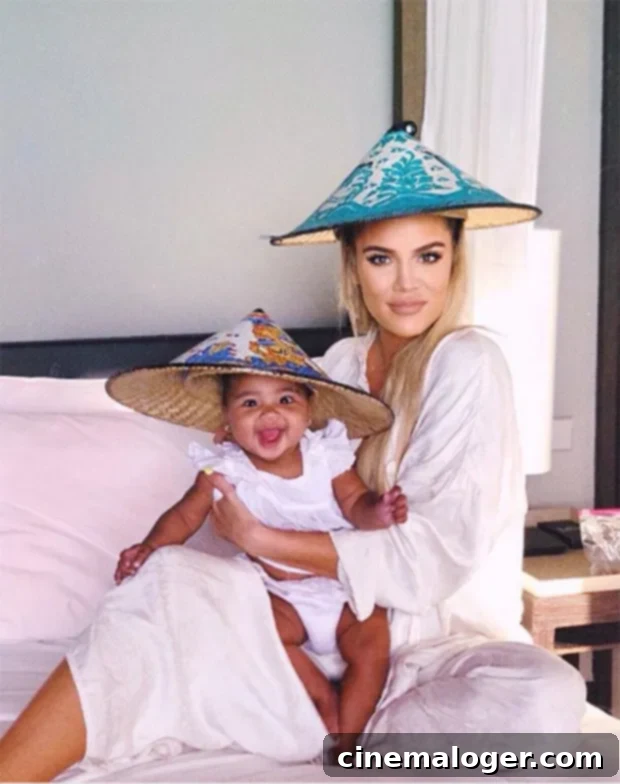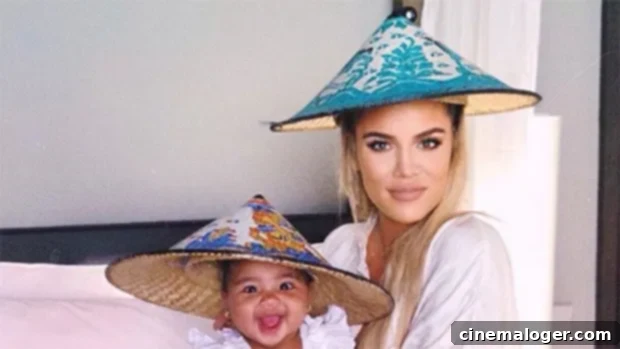Khloe Kardashian and True Thompson’s Bali Hats Spark Cultural Appropriation Debate: A Closer Look at Celebrity Fashion and Cultural Sensitivity
A recent social media post by reality television star Khloe Kardashian featuring her daughter, True Thompson, has once again ignited a fervent discussion online about cultural appropriation. The seemingly innocent “mommy and me” throwback photo from their trip to Bali quickly drew criticism for their choice of headwear, prompting many fans to voice their discomfort and question the family’s understanding of cultural etiquette.
The image, shared by Khloe Kardashian, captured a sweet moment between her and baby True Thompson, adorned with wide, conical hats. While many comments lauded True’s adorable smile, a significant portion of the feedback honed in on the hats. One direct comment stated: “Cultural Appropriation.” Others were more explicit, with one fan writing, “White girl with a black baby in a Chinese get up,” highlighting the perceived disconnect. Another follower added, “Could have done without the hats but okay,” acknowledging the photo’s charm while subtly criticizing the accessories. A more stern response urged Khloe, “please do not teach your child that cultural appropriation is acceptable DO BETTER.” The intensity of these reactions underscores a growing public demand for celebrities to be more mindful of their cultural representations.
Understanding the Controversy: Khloe Kardashian’s “Mommy and Me” Photo and Public Scrutiny
The hats worn by Khloe and True are commonly known as Asian conical hats, recognized globally but particularly prevalent across Southeast and East Asia. These traditional hats are often referred to as “rice hats,” “coolie hats,” or “bamboo hats” in English, depending on regional variations and historical context. Their function is primarily practical, providing protection from the sun and rain, and they hold deep cultural significance in many communities, symbolizing agricultural heritage, regional identity, and traditional ways of life.
The core of the controversy stems from the perception that Khloe and True, as Western celebrities, are wearing these hats as mere fashion accessories without acknowledging or respecting their cultural origins and significance. As one fan succinctly put it, “Cultural Appropriation??? Lol don’t come at me, but..” While True undeniably looks charming in the vacation photo, Khloe’s choice of accessories has, for many, marred the otherwise endearing image. This incident is compounded by the fact that the Kardashian-Jenner family, including Khloe herself, has faced numerous accusations of cultural appropriation in the past, leading to a pattern of behavior that many find increasingly problematic and unaddressed.
What is Cultural Appropriation? Distinguishing Appreciation from Misappropriation
To fully grasp the nature of this controversy, it’s essential to understand what cultural appropriation entails. Cultural appropriation is generally defined as the adoption or use of elements of a minority culture by members of the dominant culture without understanding or respecting the original culture, often for personal gain, fashion, or entertainment. It differs significantly from cultural appreciation, which involves respectfully engaging with, learning from, and honoring another culture, often with permission or in a way that benefits the originating community.
The key distinctions often lie in:
- Power Dynamics: Appropriation typically occurs when a dominant group takes from a marginalized group, where the power imbalance means the dominant group can often benefit (e.g., financially, socially) while the originating culture may face discrimination or lack recognition.
- Context and Respect: Appreciation involves understanding the historical, spiritual, or practical context of a cultural element and engaging with it respectfully. Appropriation often strips these elements of their original meaning, reducing them to mere trends or costumes.
- Permission and Benefit: True appreciation often involves seeking permission or collaborating with members of the originating culture and ensuring that they benefit from the engagement, rather than simply taking and profiting.
In the context of the Asian conical hat, critics argue that Khloe Kardashian, as a wealthy Western celebrity, is taking a culturally significant item from predominantly Asian communities and reducing it to a quaint “vacation prop” without acknowledging its deeper meaning or the people who traditionally wear it for functional and cultural purposes. This perceived trivialization is what often sparks outrage.
The Significance of the Asian Conical Hat (Nón Lá): More Than Just an Accessory
The Asian conical hat, known as “nón lá” in Vietnam, “dǒulì” in China, or variations across other Asian countries, is far more than a simple accessory. For centuries, it has been an indispensable part of daily life for farmers, fisherfolk, and street vendors, offering essential protection from intense sun and torrential rain. Beyond its practical utility, the hat carries profound cultural and historical weight.
In Vietnam, for instance, the nón lá is often a symbol of national identity, elegance, and resilience. It appears in traditional dances, songs, and poetry, often associated with the grace of Vietnamese women. Different regions might have unique styles or materials, reflecting local craftsmanship and traditions. To wear such a hat is to connect with generations of history and a specific way of life.
When someone outside of these cultures wears it without understanding this rich context, especially for a fleeting social media post, it can be seen as an act of trivialization. It reduces a symbol of heritage and practicality to a mere aesthetic choice, stripping it of its deep-rooted meaning and potentially commodifying a cultural emblem for a Western gaze. This is precisely why many fans expressed disappointment and concern when Khloe and True were pictured in them during their Bali vacation.

A Pattern of Accusations: The Kardashian Family’s History with Cultural Appropriation
The current criticism is not an isolated incident but rather part of a recurring pattern for the Kardashian-Jenner family. Their immense platform and influence mean that their sartorial choices and social media posts are scrutinized heavily, and often, this scrutiny reveals a perceived lack of cultural sensitivity.
The Dubai Niqab Incident (2015)
Khloe faced significant backlash following a 2015 trip to Dubai. She posted a photo of herself wearing a niqab, a veil worn by some Muslim women in public that covers all of the face except the eyes. While some felt she was embracing local culture, many found it deeply problematic. Critics argued that she was appropriating Muslim culture and treating a garment with religious and cultural significance as a fashion statement or a “costume,” especially given that she was not required to wear it and likely did not understand its spiritual depth or the everyday experiences of Muslim women who choose or are required to wear it.
The Native American Headdress Controversy
Another widely criticized throwback photo showed Khloe wearing a full Native American headdress. This item is profoundly sacred to many Indigenous communities, symbolizing spiritual power, leadership, and acts of bravery; it is earned, not simply worn. For a non-Indigenous person, particularly a celebrity, to don a headdress as a fashion accessory or costume is considered a grave disrespect and a gross appropriation of deeply meaningful cultural and spiritual symbols, stripping them of their profound context and trivializing generations of tradition and struggle.
Hairstyle Debates: Boxer Braids (Cornrows) and Bantu Knots
The Kardashian-Jenner sisters, including Khloe, Kim Kardashian, and Kylie Jenner, have also been frequently criticized for their hairstyle choices. They have been bashed for wearing “boxer braids,” a term they popularized for what are essentially cornrows—a traditional African and African Diaspora hairstyle with a rich history dating back thousands of years. Similarly, their use of Bantu knots, another historical and protective hairstyle originating from Southern Africa, drew condemnation. The issue here is often the double standard: when Black women wear these styles, they are sometimes deemed “unprofessional” or “ghetto,” yet when white celebrities adopt them, they are celebrated as “trendy” or “innovative,” erasing the cultural origins and overlooking the systemic biases faced by Black individuals.
The “Sheik P***y” Photo and Khloe’s Apology
One particularly egregious incident involved a photo Khloe posted where she wore a lace veil, while Scott Disick and a friend were dressed in traditional Arabian outfits. The picture was offensively titled, “Sheik P***y.” The combination of the attire and the crude caption caused widespread outrage, deemed disrespectful to Arab culture and misogynistic. Khloe later issued an apology for this specific incident:
“I’m really upset that I’ve offended anybody. I’m even more bothered that the commenters think I’m poking fun at their culture. I didn’t realize how offensive it was. I didn’t know I was doing anything wrong. I really just have to be more aware of what I write, even if I think it’s tongue in cheek and I have to be more sensitive to that. I’m sorry to anybody I offended. That was the last thing I ever wanted to do.”
While this apology expressed remorse for causing offense and acknowledged a lack of awareness, critics often scrutinize such statements for genuinely addressing the underlying issues of cultural sensitivity and understanding, rather than simply regretting the backlash. The repeated nature of these incidents, despite previous apologies, often leads to skepticism about whether true learning and change have occurred.
The Impact of Celebrity Influence and the Call for Greater Awareness
Celebrities wield immense power and influence through their platforms. Their choices, whether in fashion, travel, or lifestyle, are often amplified globally, reaching millions of followers. This influence carries a significant responsibility to be culturally aware and sensitive. When figures like Khloe Kardashian engage in what is perceived as cultural appropriation, it not only causes offense to the communities whose cultures are being misused but also potentially normalizes such behavior for their vast audience.
The ongoing dialogue around cultural appropriation highlights a broader societal shift towards demanding greater respect for diverse cultures and recognizing historical power imbalances. It’s a call for individuals, especially those in positions of power or visibility, to educate themselves, engage thoughtfully, and consider the impact of their actions beyond superficial aesthetics. The internet and social media have empowered marginalized voices to speak out directly and hold influential figures accountable, fostering a more critical and nuanced conversation about cultural exchange.
Moving Forward: Learning from Past Mistakes
As of the publication of this article, Khloe Kardashian has not yet publicly responded to the criticism surrounding the “bamboo hats” photo. The silence, in the wake of repeated past controversies and apologies, adds another layer to the discussion. While vacation photos are meant to capture joyful memories, this incident serves as another reminder that for public figures, every posted image can become a platform for critical social commentary. The expectation for celebrities to demonstrate genuine cultural understanding and sensitivity continues to grow, urging them to move beyond superficial apologies towards proactive education and respectful engagement with global cultures. The ongoing conversation underscores the importance of thoughtful choices and the profound impact of actions, even seemingly small ones, in an interconnected world.
